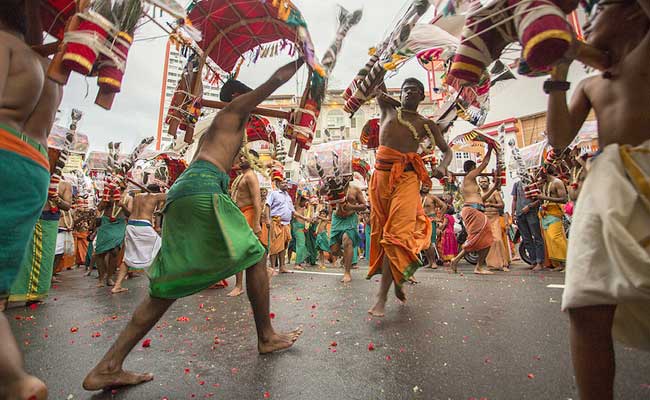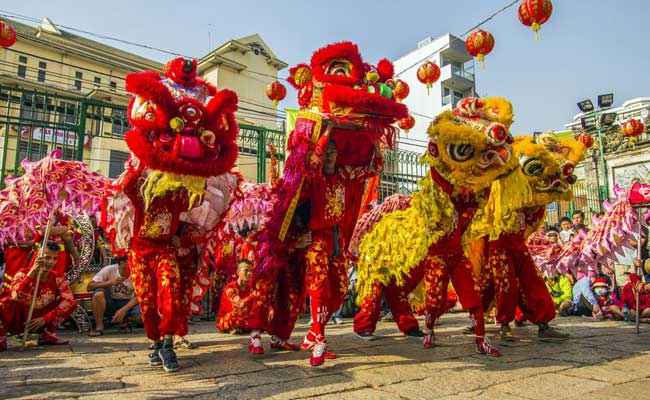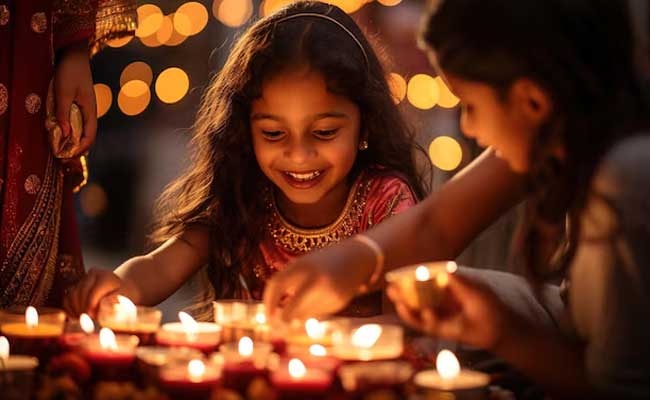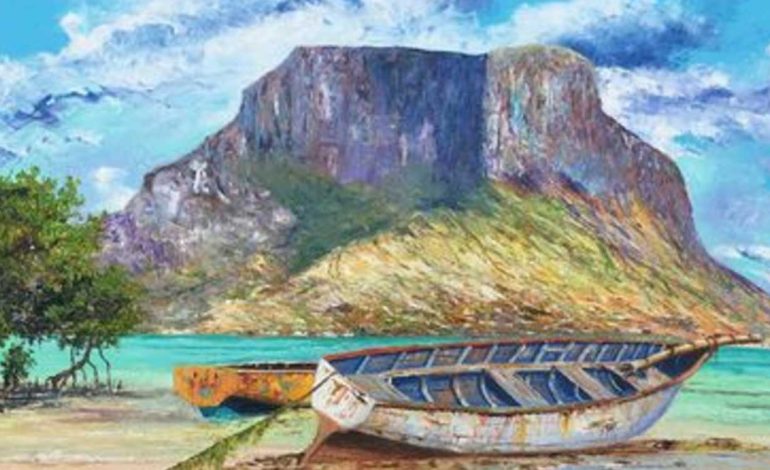Mauritius, an island nation in the Indian Ocean, is renowned for its rich tapestry of cultures and traditions. This diversity is vividly showcased through its numerous festivals celebrated throughout the year. From Hindu festivals to Chinese New Year, each celebration brings a unique flavour to the island’s cultural landscape. Join me as we explore some of the most captivating festivals in Mauritius, and discover the beauty and traditions that make them so special.

Thaipusam Cavadee: A Festival of Penance and Devotion

Thaipusam Cavadee is a deeply spiritual Hindu festival celebrated predominantly by the Tamil community in Mauritius. This festival, which falls in the Tamil month of Thai (January/February), is a time of intense penance, devotion, and the fulfilment of vows. The primary focus of Thaipusam is to seek blessings from Lord Murugan, the Hindu god of war and victory, and to show gratitude for prayers answered.
Preparation and Devotion: The journey to Thaipusam Cavadee begins well before the actual day of the festival. Devotees undertake rigorous preparations that include strict fasting and continuous prayers, often starting ten days in advance. This period of abstinence and meditation is essential for the spiritual cleansing and mental fortitude required to participate in the festival. The central ritual involves the preparation of the “Cavadee,” a wooden arch adorned with flowers, peacock feathers, and other decorative items, symbolising the mythical mountain carried by the devotee.
Rituals: On the day of Thaipusam, devotees gather early in the morning to begin their pilgrimage to the temple. They engage in acts of self-mortification to demonstrate their unwavering devotion and faith. The most striking aspect of these rituals is the piercing of the body with needles, skewers, and hooks. Devotees pierce their tongues, cheeks, and other parts of their bodies, often attaching small pots of milk or other offerings to the hooks. This act of piercing is not only a physical test but also a spiritual one, symbolising the suppression of the ego and the endurance of pain to attain divine blessings.
Vibrant Processions: The pilgrimage to the temple is marked by vibrant processions filled with fervour and colour. Devotees, carrying their elaborately decorated Cavadees, walk barefoot over considerable distances. The streets come alive with the rhythmic beat of traditional drums, the resonant sound of religious chants, and the sight of devotees in a trance-like state, moving as if guided by an unseen force. Spectators line the streets, offering support and prayers, creating an atmosphere of collective spiritual energy and community solidarity.
Purpose and Significance: The primary purpose of Thaipusam Cavadee is to fulfil vows made to Lord Murugan, seek his blessings, and show gratitude for his protection and guidance. It is believed that the intense physical and spiritual efforts made by the devotees during the festival bring them closer to the divine. The festival also serves as a reminder of the virtues of discipline, humility, and devotion. For many, it is a transformative experience, offering a sense of purification and renewal.
Thaipusam Cavadee is not only a demonstration of personal faith but also a vibrant cultural event that showcases the rich traditions of the Tamil community in Mauritius. It is a time when the community comes together to support one another in their spiritual journeys, reinforcing social bonds and cultural identity.
Chinese New Year: A Joyous Celebration of New Beginnings

Chinese New Year, also known as the Spring Festival, is one of the most vibrant and joyous festivals celebrated in Mauritius. Marking the beginning of the Lunar New Year, this festival is deeply rooted in Chinese culture and traditions, bringing together families and communities in a grand celebration of renewal, prosperity, and happiness.
Decorations and Traditions: The preparations for Chinese New Year begin weeks in advance, as families thoroughly clean their homes to sweep away any bad luck and make way for good fortune. The island is transformed with a sea of red, a colour symbolising good luck and warding off evil spirits. Red lanterns adorn streets and homes, while red couplets with auspicious phrases are pasted on doors and windows. These decorations are believed to invite prosperity and happiness in the coming year. Traditional paper cuttings and intricate patterns also decorate homes, adding to the festive atmosphere.
Feasts and Delicacies: One of the highlights of Chinese New Year is the reunion dinner, held on New Year’s Eve. This dinner is a significant tradition, symbolising family unity and togetherness. Families come together to enjoy a lavish feast featuring a variety of traditional dishes. Dumplings, shaped like ancient Chinese silver ingots, represent wealth and prosperity. Spring rolls, with their golden colour, symbolise wealth. Nian gao, or sticky rice cake, is eaten to signify progress and advancement in the coming year. Each dish served during the reunion dinner holds symbolic meaning, reflecting the hopes and wishes for the New Year.
Lion and Dragon Dances: The streets of Mauritius come alive with the mesmerising lion and dragon dances, an integral part of Chinese New Year celebrations. Performers don elaborate lion and dragon costumes, dancing to the rhythmic beat of drums, cymbals, and gongs. The lion dance, performed in pairs, is believed to bring good luck and chase away evil spirits. The lion’s movements are lively and energetic, showcasing strength and bravery. The dragon dance, involving a team of dancers manipulating a long, flexible dragon puppet, symbolises power, dignity, and good fortune. The undulating movements of the dragon, accompanied by the loud and festive music, captivate audiences and create a sense of awe and excitement.
Purpose and Significance: Chinese New Year is a time for renewal, family reunions, and honouring ancestors. It is an occasion to bid farewell to the old year and welcome the new one with hope and optimism. The festival emphasises the importance of family, as members travel from far and wide to be together, strengthening family bonds and creating lasting memories. The various customs and rituals performed during Chinese New Year, from cleaning and decorating homes to enjoying traditional feasts and participating in lion and dragon dances, are all aimed at attracting good luck, prosperity, and happiness in the year ahead.
The celebration of Chinese New Year in Mauritius is a testament to the island’s cultural diversity and the harmonious coexistence of different communities. It is a time when the Chinese community shares its rich cultural heritage with others, fostering mutual understanding and respect. The festival’s joyous and inclusive nature brings people together, creating a vibrant and festive atmosphere that is enjoyed by all.
Eid al-Fitr: A Celebration of Breaking Fast and Community

Eid al-Fitr is a significant and joyous festival for the Muslim community in Mauritius, marking the end of Ramadan, the holy month of fasting and spiritual reflection. Known as the “Festival of Breaking the Fast,” Eid al-Fitr is a time of communal prayers, charity, and festive meals, symbolising the values of gratitude, generosity, and togetherness.
Community Prayers: The celebrations of Eid al-Fitr begin with the special communal prayers known as Salat al-Eid, held in mosques and open grounds across Mauritius. Early in the morning, Muslims gather, dressed in their finest new clothes, to perform these prayers. The atmosphere is filled with a sense of unity and devotion as the community comes together to give thanks for the strength and patience granted during Ramadan. The prayer service includes a sermon that emphasises the importance of charity, forgiveness, and the spirit of community. After the prayers, people greet each other with “Eid Mubarak,” exchanging heartfelt wishes for peace and prosperity.
Charity and Giving: One of the central tenets of Eid al-Fitr is the practice of Zakat al-Fitr, a form of charity given to the poor and needy. This obligatory act of giving ensures that everyone, regardless of their financial status, can partake in the celebrations and enjoy the festive meals. Zakat al-Fitr is usually given in the form of food or money and is distributed before the Eid prayers, symbolising the purification of one’s wealth and the spirit of generosity. The act of charity reinforces the community’s solidarity and commitment to social justice, making Eid al-Fitr not only a celebration but also a time of compassion and empathy.
Festive Meals: Eid al-Fitr is also a time for joyous feasting, bringing families and friends together to enjoy an array of delicious dishes. The celebratory meals are a culmination of the month-long fasting and are often prepared with great care and love. Traditional dishes like biryani, a fragrant rice dish with meat and spices, and kebabs, grilled or roasted meat skewers, are commonly served. Sweets play a significant role in the festivities, with sheer khurma, a rich and creamy vermicelli pudding made with milk, dates, and nuts, being a favourite. The sharing of these sumptuous meals reflects the joy of the occasion and the gratitude for the blessings received.
Purpose and Significance: Eid al-Fitr holds profound spiritual and social significance. It marks the successful completion of Ramadan, a period of intense devotion, self-discipline, and reflection. The festival is an opportunity for Muslims to express gratitude to Allah for the strength to fast and to seek forgiveness for past sins. It is also a time for reconciliation, with many taking the occasion to mend broken relationships and foster harmony within the community. The emphasis on charity and sharing underscores the importance of caring for those less fortunate, reinforcing the values of empathy and compassion that lie at the heart of Islam.
In Mauritius, Eid al-Fitr is a vibrant and inclusive celebration that highlights the island’s cultural diversity. The Muslim community’s rich traditions and customs are shared with friends and neighbours, fostering mutual respect and understanding. The festival’s joyous spirit and the sense of community it engenders make Eid al-Fitr a cherished occasion for all who celebrate it, a testament to the enduring values of faith, family, and fellowship.
Divali: The Festival of Lights

Divali, also known as Diwali, is one of the most significant and widely celebrated festivals in Mauritius. This Hindu festival, known as the Festival of Lights, symbolises the victory of light over darkness and good over evil. Celebrated with great enthusiasm and joy, Divali brings together families and communities in a vibrant display of lights, fireworks, and delicious sweets.
Lighting Diyas: One of the most iconic aspects of Divali is the lighting of diyas, small earthen lamps filled with oil. These lamps are placed in and around homes, creating a warm and inviting glow that dispels the darkness. The lighting of diyas is symbolic of the triumph of light over darkness and knowledge over ignorance. In addition to diyas, homes are decorated with colourful rangoli designs, intricate patterns made on the floor using coloured powders, rice, or flowers. These beautiful decorations are believed to welcome the goddess Lakshmi, the deity of wealth and prosperity, into the home. Fairy lights and other decorative lights also adorn houses, adding to the festive atmosphere.
Fireworks: As the night falls, the sky above Mauritius is lit up with dazzling fireworks, a highlight of the Divali celebrations. The bursting of firecrackers and fireworks is a joyous expression of the festive spirit and is believed to ward off evil spirits. The spectacular display of colours and lights creates a sense of excitement and wonder, bringing communities together to celebrate. Families and friends gather outside to watch the fireworks, share laughter, and revel in the collective joy of the festival.
Traditional Sweets: Divali is also a time for culinary delights, with the preparation and sharing of traditional sweets being an integral part of the celebrations. Families come together to make a variety of sweets such as ladoos, barfis, and gulab jamuns. Ladoos are round, sweet confections made from flour, sugar, and ghee, often flavoured with cardamom and nuts. Barfis are dense, milk-based sweets, often decorated with edible silver leaf. Gulab jamuns are soft, spongy balls made from milk solids, soaked in a fragrant sugar syrup. These sweets are not only enjoyed by family members but are also shared with neighbours and friends, symbolising the spirit of sharing and community.
Purpose and Significance: Divali holds deep cultural and spiritual significance. It commemorates the return of Lord Rama, along with his wife Sita and brother Lakshmana, to Ayodhya after 14 years of exile and his victory over the demon king Ravana. The people of Ayodhya lit oil lamps to celebrate their return, and this tradition continues today. Divali also honours the goddess Lakshmi, with prayers and rituals performed to seek her blessings for wealth and prosperity. The festival serves as a reminder of the power of good to triumph over evil and the importance of knowledge and wisdom in dispelling ignorance.
In Mauritius, Divali is celebrated by people of all communities, reflecting the island’s rich cultural diversity and spirit of inclusiveness. The festival fosters a sense of unity and togetherness, as people from different backgrounds come together to participate in the festivities. The joyous celebrations, filled with lights, music, and delicious food, create an atmosphere of warmth and happiness that is cherished by all.
Christmas: A Joyous Celebration of Unity and Festivity

Christmas is a widely celebrated festival in Mauritius, bringing together people from different cultural backgrounds in a spirit of joy, unity, and festivity. The holiday season transforms the island into a vibrant and festive landscape, where the celebration of the birth of Jesus Christ fosters a sense of community and togetherness.
Festive Decorations: In the weeks leading up to Christmas, the streets, homes, and shopping centres of Mauritius are beautifully decorated, creating a magical and festive atmosphere. Christmas trees, adorned with sparkling lights, colourful ornaments, and shimmering tinsel, become the centrepiece of decorations in homes and public spaces. Streets and buildings are illuminated with an array of lights, casting a warm and enchanting glow over the island.
Shopping centres and markets are bustling with holiday shoppers, and festive displays and decorations add to the excitement. The sight of Santa Claus, reindeer, and nativity scenes further enhances the holiday spirit.Midnight Mass: A central tradition of Christmas in Mauritius is the midnight mass held in churches across the island. On Christmas Eve, people of all ages gather in beautifully decorated churches to celebrate the birth of Jesus Christ. The midnight mass is a deeply spiritual and communal event, filled with prayers, hymns, and carols. The church bells ring out, and the congregation joins in singing Christmas carols, creating a sense of unity and reverence. The mass culminates in the joyous proclamation of Christ’s birth, and the sharing of peace and goodwill among attendees. This sacred celebration emphasises the true meaning of Christmas and brings the community together in faith and worship.
Family Gatherings: Christmas in Mauritius is a time for family gatherings, where loved ones come together to celebrate and create lasting memories. Families exchange gifts, a tradition that symbolises the sharing of love and joy. The excitement of unwrapping presents is accompanied by expressions of gratitude and happiness. The festive meals during Christmas are a highlight, with tables laden with a variety of delicious dishes. Roasted meats, such as turkey and ham, are often the centrepiece, accompanied by an array of sides and salads. Traditional cakes, cookies, and desserts add a sweet touch to the celebrations. Popular treats include Christmas pudding, yule logs, and mince pies. The sharing of these sumptuous meals reflects the spirit of abundance and togetherness that defines Christmas.
Purpose and Significance: Christmas is a celebration of the birth of Jesus Christ, symbolising hope, love, and redemption. It is a time to reflect on the values of compassion, generosity, and goodwill. The festival serves as a reminder of the importance of family and community, and the joy that comes from giving and sharing with others. The festive decorations, the communal worship, and the family gatherings all contribute to the creation of a joyous and inclusive atmosphere that transcends cultural and religious boundaries.
In Mauritius, Christmas is not just a religious celebration but a cultural event that brings people together. The island’s multicultural population embraces the festivities, making it a time of unity and shared joy. The celebration of Christmas in Mauritius highlights the island’s rich cultural diversity and the harmonious coexistence of its people. Whether through the twinkling lights, the melodious carols, or the delightful feasts, Christmas in Mauritius is a heartwarming experience that brings a sense of peace, happiness, and togetherness to all who celebrate it.
Conclusion
The cultural festivals of Mauritius are a testament to the island’s rich heritage and the harmonious coexistence of diverse communities. Each festival offers a glimpse into the traditions, values, and vibrant spirit of the people of Mauritius. Whether you’re a local or a visitor, experiencing these festivals is a journey through the heart and soul of Mauritius.


